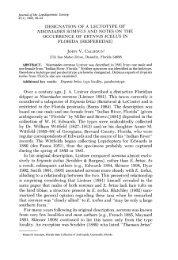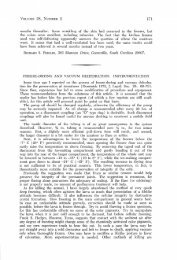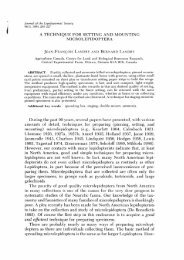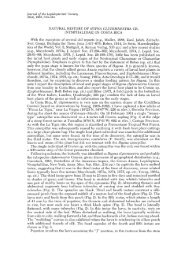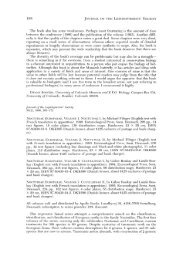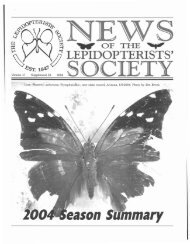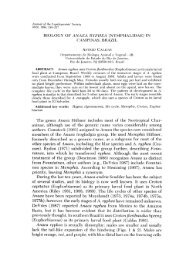HOW TO MAKE REGIONAL LISTS OF BUTTERFLIES - Yale University
HOW TO MAKE REGIONAL LISTS OF BUTTERFLIES - Yale University
HOW TO MAKE REGIONAL LISTS OF BUTTERFLIES - Yale University
Create successful ePaper yourself
Turn your PDF publications into a flip-book with our unique Google optimized e-Paper software.
VOLUME 33, NUMBER 4 223The "hypothetical list." Ornithologists are familiar with this term;lepidopterists are not. In your published list itself, include onlyspecies with established reliable records. Save the rest for the "hypotheticallist" at the end. It is the perfect place for the doubtfulspecies, the "possibles," those previously reported in error. Anythingdubious can go in. This device allows you to avoid the difficult decisionof what to include in, and what to exclude from, the main list.Amplify and discuss the entries as you will. The "hypothetical list"is a wonderful place for the reader to browse when your paper iseventually published.The work of assembling a state list is never done. Information alwaysremains to be learned, and always will. The trick is knowingwhen you have reached the point when you can properly say, "Thisis now worth publishing." Eventually the time comes when you havea reasonable picture of the butterflies of your state, embodying a satisfyingquantity of new data. If at this point the influx of new infor~mation slows, then the time clearly has come to put it all together andget it into print.As the foregoing should have intimated, preparing a state list is nota simple task. It requires experience, knowledge, and judgement, aswell as diligence. It is not really a job for a beginner. If you are abeginner, however, and you really want to undertake such a task, thenyou should seek as much advice and help as you can from those withmore experience. If you do that, then there is no reason not to producean excellent and valuable piece of work.LOCAL STUDIESA local study, as I use the term here, is an intensive, long-terminvestigation of a small area: perhaps one or two thousand acres, aboutas much as can be covered reasonably well on foot in a single day.Studies of this kind have been undertaken so seldom that whereveryou choose to do so you will be rewarded with significant data, wellworth publishing. Because it requires no extensive collections and nolarge reference library this kind of study is particularly suited to theserious lepidopterist in a rural area. Bear in mind that much of theinformation you acquire, even though it seems of little interest initself, will gain greatly in value when added to similar informationfrom elsewhere. Among the most important eventual results of suchwork will be establishing geographic patterns of variation in broodnumbers and timing, larval foodplant choice, abundance levels, andother things about which we are still totally, or almost totally, ignorant.




